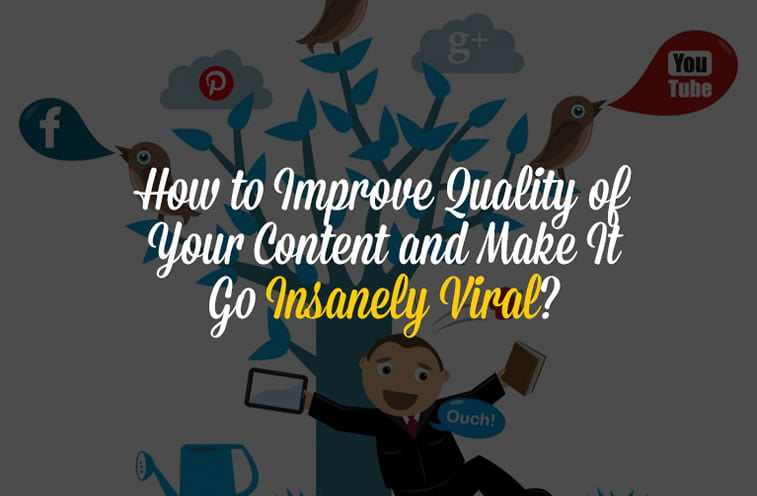In the ever-changing world of digital technology and IT improvements, we are facing new challenges on a daily basis. One of them is providing your audience with good content.
So, in the following paragraphs you will find out what is meant by ’content’, get a deeper insight into the psychology of content sharing, find interesting tips on how to improve your content and avoid silly mistakes all beginners tend to make.
Basic definitions: what is viral content?
People seek content all the time. Be it a book, online newspaper, regular newspaper, video game, TV show, music video, that app on your smartphone or tablet – it can all pass as content.
Content is what makes us amused, it is all those interesting things we stumble upon; it is information, knowledge, the essence of every talk.
In the world of the Internet, content is everywhere – it is on the Newsfeed section of your Facebook account, you share it on your wall or timeline, you tweet about it or pin it to your other social media profiles, or you send it in email body with a funny message to your mailing list and contacts.
In the information age, it is important to bring content into focus of every marketing strategy you are planning to employ. Do not let your audience be cheated, give them what they expect, and get feedback from them.
Additionally, Merriam-Webster’s Online Dictionary defines viral as
quickly and widely spread or popularized especially by person-to-person electronic communication,
which means that viral content is something which is very popular and thus shared via electronic media and social networks.
The psychology of content sharing
Before we start discussing viral strategies, let us first go deeper into the psychology of content sharing. Many people wonder how or why some articles or videos go insanely viral within a few hours. To answer that question we need to see what makes them click the share or like button.
One of the possible answers could be that the content says something about them, that is, they agree with the idea or concept presented through that piece of content. So by sharing it, they express a part of their personality and show their individual preferences.
Another answer could be that your content earns trust of your target audience, so by clicking it they know that they are going to get quality. However, it takes time to get to be trusted by your target audience, and success will surely not come overnight.
Motivation can also play a significant role in content sharing, so if your audience is drawn and promised to get something, they sure are going to press that button and like your product.
And finally, everything evolves around a great idea, so if you offer something new, something that solves (potential) problems your audience is faced with every day (and add crucial, engaging hashtags, of course), your content can go viral in a matter of minutes.
How to make your content go viral?
Good content is nothing without target audience
Before you start writing/recording or do whatever your expertise is, you need to think about your target audience – that is, the people who are going to receive your content and want to share it.
When thinking about people, you need to know that they are of flesh and blood, they have their fears and emotions, and they want to be acknowledged. In order to see what they need, you need to approach them from a down-to-Earth perspective and truly listen and make notes about improving their life or making it easier. A good listener will know that this can, in fact, determine the very direction of where your content is going to end up, so play this step carefully.
If you are not sure what to do or how to search for problems that need to be solved in your industry, here is an interesting starting point – Content Marketing Institute can help you find the best pieces of content in your industry.
Another way is to conduct a research via social networks, make polls and get the information from your audience firsthand. Find out everything you can about them, use metrics in your advantage and follow their social circles closely to get to know them better. If your target audience spends a lot of time on one particular social media network, make sure to be there and communicate your message.
Once you have this in mind, you can start writing an outline of your content project. No matter if it is a video, song or an essay, you need to make a good plan, with the purpose, title, sections and the concluding message you are planning to achieve via your upcoming content.
The 80:20 rule
According to the Pareto principle, or the 80-20 rule,
roughly 80% of the effects come from 20% of the causes.
When talking in terms of content marketing, this actually means that you should spend 20% of your time on writing content, and the rest – 80% – on promoting it via social media and offline campaigns.
If you opt for social platforms, make sure to have a good business profile and that your content appears trustworthy enough. Never betray your readers/followers and use the Developers page to actually see the response of your work. You can get direct feedback from your audience if your content is engaging enough, and you can see what lies beneath that social media buzz by following metrics pages and other SEO tools the experts can do instead of you. Do not be afraid of investing into Google’s AdWords, Facebook’s paid campaigns and the like. It takes time to engage your audience and build a tribe, so waiting will pay off eventually.
Emotional response
The destiny of your content is going to depend on how your audience feels. If you have not done the research well, the odds are that your content is going to be unnoticed on social networks. However, if your content is compelling and if it causes different emotions which work in your target audience, the odds of your content going viral are rising.
Nevertheless, you need to know which emotions count, and these are the following:
- Happiness
- Joy
- Laughter
- Excitement
- Inspiration
- Heart-melting
- Upsetting
- Pride
- Primal emotions: fear, anger, fury, terror
- Disgust
- Contempt
- Confusion
Another thing which needs to be taken into consideration is social trigger. This means that if a person from your friends list has given kudos (a type of social currency) to some content, it is actually giving that content a sparkle to be shared more.
Additionally, emotional response can be provoked with good, structured stories, animals, babies, celebrities, familiarity, music, branding, weather, and many more – so choose something close to your niche and start typing.
Create content
Just like with every other phase of the process, creating your content will take some time. Once you have conducted your audience research, and decided on the way of approaching them, it is high time you determined the structure, which can be as follows:
- Write a killer headline
- Divide the text into sections, paragraphs with subheadlines
- Conclude, and
- Give a summary to help your audience get the message you were aiming at
Do not forget to read the text (or revise other types of content) a few times before publishing it. Having typos only means that you did not dedicate enough time to revising and checking it, so it would be best if you avoided the possible negative comments.
Optimize your content
It would be a waste of time and money if you did not optimize your content. If you think that leaving the content in aether is going to make it go viral on its own, you should know that it will not happen magically. Your content is in desperate need of a good headline, search engine optimization (you can hire a great agency providing SEO services to help you with this)
Avoid these mistakes:
- Not using technology
Content marketing has become the art and science, so it would be a shame not to use all the benefits of technology in this creative industry. Use as many tools you need, and follow metrics and do analytics to improve your future work.
- Not hustling your content
The sooner you realize that one post or one email a month will not do the trick – the better. You need to push your content and draw attention to it, because people, at this stage, will not come on their own.
- Not experimenting
Move from comfortable areas of interest and do some experimenting. Apply the 70/20/10 investment principle, which means that 70% of your content is of low risk, 20% is innovative, and 10% risky with two possible outcomes: to either fail, or become the next 20% or 70%.
- Not learning from your mistakes
Not everyone is born wise, so it is okay to make mistakes sometimes. If you make them, it means that you have tried and found out what works and what does not, so you need not be desperate about it.
In this text, we have outlined the basic strategies which can help you improve your content and help it become popular on social networks. Since there are many factors which can influence the process, one of them being sheer luck, we recommend you experiment a lot and talk to other marketers for fresh ideas. Never stop wondering how to improve your business and success will come.





